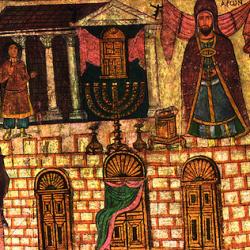Many scholars have pointed to the fact that the tabernacle is an architectural representation of Mount Sinai. The tabernacle is divided into three zones – court, holy place, most holy place – with different degrees of access; Sinai was organized the same way. The altar of ascensions in the courtyard was itself a mini-Sinai: Topped with fiery smoke, the altar resembled the smoking mountain, and the warning against touching the altar replicated the warning about touching Sinai.
If this is true, then, as James Jordan pointed out in a recent Theopolis lecture, the tabernacle is also a portable wilderness. If Israel returned to Sinai every time she met with Yahweh, she also retreated into the wilderness.
That sheds considerable light on the significance of the tabernacle in Israel’s life. The wilderness was the liminal space between Egypt and the promised land, and by erecting the tabernacle in the land, Israel retained a bit of that liminal space. Every festival (especially Booths) was a reenactment of the exodus and the progress toward the land. Worship wilderness retreat.
This dimension of the tabernacle complicated, though it doesn’t cancel out, the apparently opposite symbolism of the tabernacle-as-garden. After all, Yahweh formed a garden out of the wilderness by providing abundant water at Sinai: He made the wilderness bloom like a rose. A journey to the tabernacle was a journey to the wilderness-garden.
We can also note the sequence of Israel’s sanctuaries. Despite its similarities to the tabernacle, the temple was not identical. Where it diverged from the tabernacle, it was in highlighting the garden-symbolism over the wilderness. The temple court included a huge sea of water and ten water chariots. The walls of the temple were wood, and the wood was carved into the shape of plants.
The wilderness-tabernacle connection also sheds light on Hosea’s prophecy that the Lord would entice His Bride to the wilderness to renew their marriage vows (Hosea 2:14-20). That is a promise to reenact the exodus, but it is also a promise to bring His Bride into His nuptial tent, the tabernacle, and renew His love.















